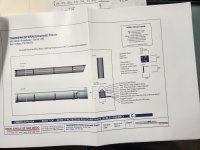jselectricservs
Member
- Location
- valinda c.a
- Occupation
- C10 Electrical Contractor
Hello,
We are removing some Neon fixtures and will be installing some led fixtures. can anyone help me with the neon wattage consumption. There are 30 fixtures with, 12,000volt 30ma (milliamp) transformers. Is this math correct? 12,000v x .03a = 360watts. There are 30 of them, so total energy consumption of 10,800 watts (10.8kW)? Is there different calculations for neon?
see photo attached for more information.
We are removing some Neon fixtures and will be installing some led fixtures. can anyone help me with the neon wattage consumption. There are 30 fixtures with, 12,000volt 30ma (milliamp) transformers. Is this math correct? 12,000v x .03a = 360watts. There are 30 of them, so total energy consumption of 10,800 watts (10.8kW)? Is there different calculations for neon?
see photo attached for more information.



